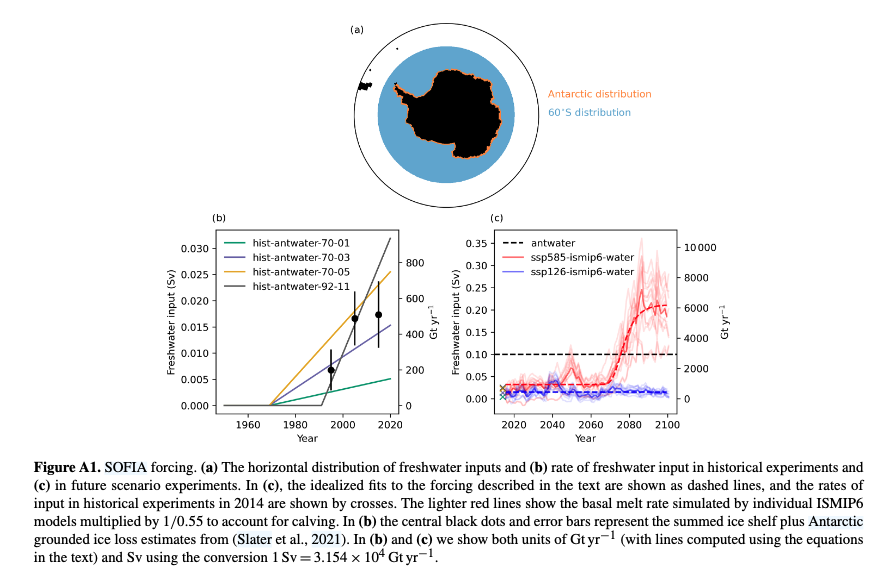LIMALOC: Long-term Impact of Meltwater from Antarctica on Large-scale Oceanic Circulations
Ocean Sciences, Climate
Research area
Meltwater from the Antarctic Ice Sheet and ice shelves, driven by climate change, is increasing and expected to accelerate under high-emission scenarios. Fresh meltwater is believed to impact deep water formation by increasing stratification, as it reduces surface water density and makes the water column less prone to deep convection.
As a result, Antarctic Bottom Water (AABW) is projected to contract. This, in turn, can potentially impact related large-scale ocean circulations such as the Atlantic Meridional Overturning circulation, with significant consequences for global climate. Additionally, meltwater could trigger self-reinforcing mechanisms, where circulation changes accelerate ice shelf melting, intensifying freshwater input and its impacts.
However, most state-of-the-art climate models that participated in the Coupled Model Intercomparison Project (CMIP6) do not account for Antarctic meltwater, leaving its effects under future scenarios poorly understood.
Project goals
As a step toward incorporating meltwater fluxes into state-of-the-art climate models, I perform simulations with the EC-Earth3 climate model as part of the Southern Ocean Freshwater Input from Antarctica Initiative (SOFIA).
In idealized preindustrial simulations, I assess the model's sensitivity to the distance of freshwater input from the Antarctic coast and the specific sector of injection. I further examine the impact of increasingly realistic configurations, accounting for the heat flux from the ocean required to melt icebergs, and for injection of freshwater over the full water column. I analyze the climate response and its relation with the initial sea ice state focusing on impacts to ocean stratification, Antarctic Bottom Water formation and the Antarctic Circumpolar Current.
I perform additional historical and future scenario simulations with combined greenhouse gas and prescribed freshwater forcing. For the future scenarios I simulate one low end and one high end scenario, for which the prescribed freshwater is derived from a multi-model mean of offline ice-sheet simulations. While these experiments investigate more realistic freshwater-forcing configurations, they do not represent ice-climate feedbacks.
For this reason, I further employ a version of EC-Earth3 coupled with a simplified coupling to the ice sheet model PISM, aiming to advance fully interactive Antarctic Ice Sheet modeling in EC-Earth through comparison of coupled and uncoupled simulations.
Computational approach
To run SOFIA simulations, I use the EC-Earth 3.3 climate model, a state-of-the-art Coupled General Circulation Model (CGCM) that participated in CMIP6. It includes the IFS atmospheric model, the NEMO ocean model (with LIM3 sea ice), the H-TESSEL surface scheme, a runoff mapper, and is coupled through OASIS3. I/O is handled via XIOS. EC-Earth3 runs at ~80 km atmospheric (T255, 91 levels) and ~100 km oceanic (ORCA1, 75 levels) resolutions.
Written in Fortran90 and parallelized with OpenMPI, it achieves 13 simulation years/day on ECMWF’s Atos machine, using five nodes with 128 cores each — 490 cores for IFS, 148 for NEMO, and one each for the runoff mapper and XIOS. Challenges like Atos’s 48-hour wall time limit are solved using auto-resubmission scripts.
Output in NETCDF (ocean) and GRIB (atmosphere) formats generates 60GB per year, requiring several terabytes of storage for 100-year simulations. Postprocessing relies on ece2cmor3, based on the Climate Data Operators (CDO) to convert data to CMIP standards (CMOR). Once the simulations are performed, the analysis is carried out with python notebooks (mainly data visualization with xarray, dask, matplotlib, cartopy).
For the Terabit use case, I intend to port EC-Earth3. Together with the technical team, I will configure the necessary modules (Fortran compiler, NetCDF, OpenMPI, CDO), adapt jobscripts, benchmark performance on the new HPC system, and set up the analysis environment.
SOFIA forcing. (a) The horizontal distribution of freshwater inputs. In this project we use the Antarctic distribution. (b) rate of freshwater input in historical experiments and (c) in future scenario experiments. In (b) the central black dots and error bars represent total ice loss estimates from (Slater et al., 2021). In (c) the fits of the ISMIP6 ensemble are shown as dashed lines, and the rates of input in historical experiments in 2014 are shown by crosses. Adapted from Swart et al 2024
Irene Trombini
CNR - ISAC; University of Bologna
I am a PhD student in Climatology at the Department of Physics of the University of Bologna working in collaboration with CNR-ISAC.
I completed my Bachelor's in Physics in Pavia and my full Master's degree in Physics in Heidelberg, Germany, supported by a scholarship of the German Academic Exchange System (DAAD).
For my Master's thesis, I worked with climate models of various complexity applied to paleoclimate, leading to my first publication, recently accepted by GRL (10.22541/essoar.172202086.64896478/v2)
In my PhD project I work with a state-of-the-art climate model with a focus on the response of large-scale ocean circulations to future greenhouse and freshwater forcing in the Southern Ocean.
As a student of Collegio Superiore, I work on climate science outreach alongside fellow PhD students. My latest dissemination project, in collaboration with performative artist Filippo Capobianco, is funded by GenerazionePlanet, a call for under-30s that we recently won.










